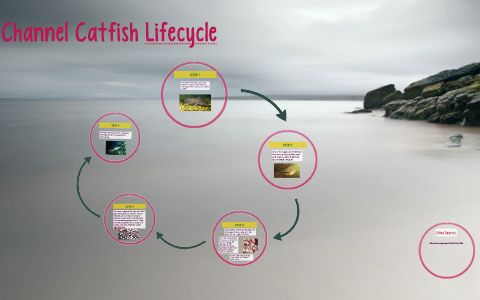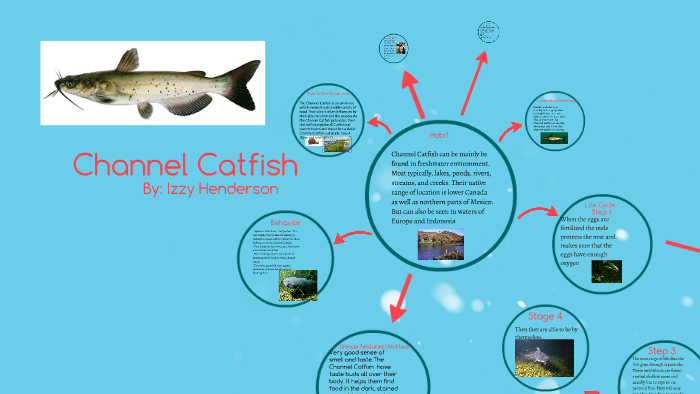
The pair builds a depression in the ground which is guarded by the male Ref. Females start laying their eggs at water temperatures above 21C 70F.

It can survive in freshwater saltwater and brackish water.
Channel catfish life cycle. Channel Catfish Life Cycle in the Hatchery. Macroscopic vs Microscopic Bauer Duke Extension Aquaculture Specialist Remove the eggs from the pond Bring the eggs to the hatchery and weigh them. Keep water flowing over the eggs as they wait for the next step.
This is usually done 24. Natural waters channel catfish do not reach 1 pound in size until they are 2 to 4 years old. One study in the Lake of the Ozarks Missouri found that channel catfish did not reach a size of 13 inches total length until they were 8 years old.
The maximum age ever recorded for channel catfish is 40 years whereas most commercially. The channel catfish spawns in Missouri from about the last week of May when water temperatures reach 75 F and continues through the third week of July. Often there are two peaks of spawning activity during this period.
Prior to spawning the male catfish selects and cleans out a nest site. Life Cycle Characteristics Channel catfish are reported to live up to forty years attain approximately 1 m 40 in in total length and nearly 20 kg 44 lbs in body weight. In the wild however fish over ten years of age 53 cm 21 in in length and 15 kg 33 lbs in body size are unusual.
Channel catfish can be sexually differentiated at about 6 months of age and normally breed for the. Discover How Long Channel catfish Lives. We use the most recent data from these primary sources.
AnAge UMICH Max Planck PanTHERIA Arkive UKC AKC. Pheromone Information When they detect anothers pheromones a catfish can tell how old they are their sex if they are receptive to breeding and how high they are in the social hierarchy. Habitat of the Channel Catfish.
Like its cousin the blue catfish the channel cat occupies a wide range of habitat types. It can survive in freshwater saltwater and brackish water. However they usually prefer.
What the post spawn is to the grand scheme of the catfish life cycle is the time when the spawn ends and the fish recuperate and move into the summer pattern where they will live out the rest of the summer months until the fall waters begin to cool. When the fish finish up spawning they must kick into high gear feeding to recuperate from the long sit without food of the spawn. In some cases.
Decreased production in channel catfish. The management strategies discussed here for the control of Bolbophorus apply to other digenet-ic trematodes with similar life cycles. Life cycle and vectors As with other digenetic trema-todes Bolbophorus has a complex life cycle involving one final host and two intermediate hosts.
Of Henneguya ictaluri in channel catfish gills. Photo courtesy of Dr. Andy Goodwin from American Fisheries Society Fish Health Section Blue Book 2014 These are the end result of the parasites life cycle and often appear 2 to 3 months after initial infection.
In 2001 Julia Whitaker and four other researchers. The channel catfish is North Americas most numerous catfish species. It is the official fish of Kansas Missouri Iowa Nebraska and Tennessee and is informally referred to as a channel cat.
In the United States they are the most fished catfish species with around 8 million anglers targeting them per year. The popularity of channel catfish for food has contributed to the rapid expansion of aquaculture of. Females lay their egges on a hole dug on sandy grounds.
Incubation lasts 3-8 days and larval development between 12-16 days depending on temperature. The pair builds a depression in the ground which is guarded by the male Ref. A typical production cycle for channel catfish farming begins with spawning of brood fish.
Spawning begins in the spring when water temperatures increase to above 70º F. At that time brood fish held in ponds randomly mate and the fertilized eggs are collected from spawning containers and moved to a hatchery. Eggs hatch after 5 to 8 days of incubation and fry are reared in the.
Channel catfish can be a variety of different colors depending on the environment they are in. Common colors include olive light blue and bluish-gray. Large freshwater fish such as flathead catfish and muskies are the predators to channel catfish.
A catfishs average lifespan is about 15-20 years. Channel catfish can be sexually differentiated at about 6 months of age and normally breed for the first time in their second or third year of life. Thereafter catfish will usually spawn every year throughout their life time.
The spawning season of channel catfish is usually during the months of April through June. Females start laying their eggs at water temperatures above 21C 70F. The eggs of channel catfish.
Populations of channel catfish. In addition the Boise River Snake and Little Wood rivers of Idaho have this species USGS site. Life-history and basic ecology Life cycle Channel catfish are native to the Midwest and eastern North America extending from Canada to Mexico Page Burr 1991.
They are generally adapted for water with low. In female channel catfish aged from left 1 to 4 years the development of ovaries increases the size of the lower abdomen particularly between 2- and 3-year-old fish. Channel catfish populations generally do not reproduce in large numbers until they are 3 years old.
In aquatic species control of reproduction or spawning is required for an effective genetic improvement program and is possible only where the culturist has control over the entire life cycle. Commercial catfish farms typically maintain thousands of broodfish and have access to wild broodstock if necessary to increase genetic variation. Large numbers 10000 to 20000 of offspring in each.
The channel catfish has a life span of between 14 to 16 years. Some individuals may live up to 40 years.